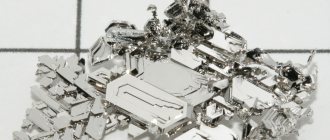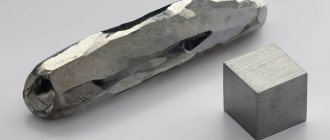A brief excursion into history
What is the name of the metal that melts in your hand? As noted above, such a material is known as gallium. Its theoretical existence was predicted back in 1870 by a Russian scientist, the author of the table of chemical elements, Dmitry Mendeleev. The basis for the emergence of such an assumption was his study of the properties of numerous metals. At that time, not a single theorist could have imagined that the metal that melts in the hands exists in reality.
The possibility of synthesizing an extremely fusible material, the appearance of which Mendeleev predicted, was proven by the French scientist Emile Lecoq de Boisbaudran. In 1875, he succeeded in isolating gallium from zinc ore. During experiments with the material, the scientist obtained a metal that melts in his hands.
It is known that Emile Boisbaudran experienced significant difficulties in isolating a new element from zinc ore. During his first experiments, he managed to extract only 0.1 grams of gallium. However, even this was enough to confirm the amazing property of the material.
Where is gallium found in nature?
Gallium is one of the elements that does not occur as ore deposits. The material is very dispersed in the earth's crust. In nature, it is found in extremely rare minerals such as gallite and zengeite. During laboratory experiments, a small amount of gallium can be isolated from the ores of zinc, aluminum, germanium, and iron. Sometimes it is found in bauxite, coal deposits, and other mineral deposits.
Areas of application
Gallium has not yet found application in industry. This is due to the widespread use of aluminum, which has similar properties in solid form. Despite this, gallium looks like a promising material because it has excellent semiconductor properties. This metal can potentially be used for the production of transistor elements, high-temperature current rectifiers, and solar panels. Gallium looks like an excellent solution for making optical mirror coatings that will have the highest reflectivity.
The main obstacle to the use of gallium on an industrial scale remains the high cost of its synthesis from ores and minerals. The price per ton of such metal on the world market is more than $1.2 million.
To date, gallium has found effective use only in the medical field. The metal in liquid form is used to slow down bone loss in people suffering from cancer. It is used to quickly stop bleeding in the presence of extremely deep wounds on the body of victims. In the latter case, blockage of blood vessels by gallium does not lead to the formation of blood clots.
As noted above, gallium is a metal that melts in the hands. Since the temperature required for the material to transform into a liquid state is slightly more than 29 o C, it is enough to hold it in your palms. After some time, the initially solid material will begin to melt literally before our eyes.
A rather fascinating experiment can be carried out with the solidification of gallium. The presented metal tends to expand during solidification. To conduct an interesting experiment, it is enough to place liquid gallium in a glass vial. Next you need to start cooling the container. After some time, you will notice how metal crystals begin to form in the bubble. They will have a bluish color, as opposed to the silvery tint that is characteristic of the material in its liquid state. If cooling is continued, the crystallizing gallium will eventually rupture the glass vial.
Gallium: a metal that melts in your hands
Truly an entertaining chemical element that can be found in any school chemistry classroom. Thanks to its demonstrative clarity, gallium is considered the best option for conveying to the minds of students the thermal properties of chemical elements.
Gallium (Ga) is a metal that melts in the hands when the temperature reaches 29.8 degrees Celsius. Considering the standard 36.6 in the human body, in order to get the desired effect, it is enough to place a piece of gallium on the palm of your hand and watch it slowly spread across it in different directions.
1) General information on the element
In the periodic table of chemical elements, gallium is in position 31.
Its Latin designation is "Ga". The metal belongs to the group of light metals, which also includes aluminum, indium, tin, thallium, lead and bismuth. Externally, gallium is a soft or brittle metal (depending on temperature) with white + silver shades. Sometimes you can notice bluish reflections on the surface of a pure substance.
The Great Mendeleev knew about this chemical element in advance. He first calculated some of the properties of gallium back in 1871. The original name assigned by the chemist sounded like “eka-aluminium”.
The predicted properties of gallium by Mendeleev included:
- oxide type;
- options for communication with chlorine;
- slow solubility in contact with alkalis/acids;
- gallium will not react with oxygen;
- the ability of a low-melting metal to form basic salts;
- the chemical element will be discovered using spectroscopy.
The direct isolation of the metal in its pure form was due to the Frenchman Boisbaudran. The opening took place in 1875. Due to the low fractional content of gallium in the ore (less than 0.2%), it was necessary to spend a couple of months obtaining a minimum supply of pure substance for a full study of its physical/chemical properties.
| Physics of gallium | Chemistry of gallium |
| The presence of several modifications of the polymorphic type. | Low chemical activity slows down the chemical reactions of the metal in the solid state. |
| Under normal conditions, the crystal lattice has an orthorhombic structure. With increasing pressure, the formation of 2 polymorphic structures with cubic and tetragonal lattices is observed. | In air, gallium is covered with an oxide film, which protects it from further oxidation reactions. |
| The density of gallium is 5.9 grams per cubic centimeter, and in the liquid state the density increases to 6.1 grams per cubic centimeter. | In contact with hot water, it displaces hydrogen from it, resulting in the formation of gallium hydroxide. |
| The electrical resistance of gallium in solid and liquid states is the same and is equal to 0.5 per 10-8 Ohm*cm at a temperature of 0 degrees Celsius. | Reacts with steam (above 340 degrees) and forms metagallic acid. |
| The viscosity of gallium varies depending on the temperature. At a temperature of 100 degrees – 1.6 centipoise, and at 1000 degrees C – 0.6 centipoise. | It can interact with mineral acids - H is released and salts are formed. |
| The surface tension is 0.74 newtons per meter, and the reflectivity is from 71% to 76% at different wavelengths. | Gallium is inert towards hydrogen, nitrogen, carbon and silicon. |
In the earth's crust, metal that melts in the hands is quite common. There are 19 grams of pure substance per 1 ton of earth. In the chemical aspect, gallium is a trace element with a dual nature in geochemistry. Although the clarke of the substance is large, due to its strong tendency towards isomorphism, large accumulations of pure gallium cannot be found in nature.
The main minerals with a relatively high content of gallium in pure form include sphalerite (up to 0.1%), biotite (up to 0.1%) and natrolite (up to 0.1%). In the remaining 10+ minerals, which are also used for gallium mining, the fractional content of pure substance is less than 0.1%. Gallium is also present in seawater, but its content is extremely low - only 30 per 10-6 milligrams per liter of liquid.
10 strongest metals in the world
2) Why is gallium a metal that melts in your hand?
Let us turn to the thermal properties of the metal, and fully analyze them at various levels, although the answer to the question is already obvious from the basic concept, the melting point, which is equated to 29 degrees Celsius.
Thermodynamic properties of pure gallium:
- the metal changes from solid to liquid when it reaches a temperature of 29.8 C or 302 degrees Kelvin;
- the metal boils when it reaches a temperature of 2,448 degrees Kelvin;
- the specific heat of fusion of pure gallium is 5600 Joules per mole;
- the specific heat of evaporation is 270,000 joules per mole;
- The molar heat capacity is 26 joules divided by Kelvin multiplied by moles.
The main suppliers of gallium to the world market are states from South-West Africa, the Russian Federation and most CIS countries. Gallium is a metal that not only melts in the hand, but also a substance that can change density when the temperature changes; based on this property, you can conduct an interesting experiment.
Experiment: we transfer gallium to a liquid state, and then we drive it into a small glass vial. As the container cools, the metal will gradually turn into a solid substance. Gradually, the formed crystals will begin to expand, due to which the flask will sooner or later crack.
To avoid damage from spectators, the demonstration should take place in an isolated area with a protective partition. If you overcool the flask too quickly, the fragments can scatter in different directions within a radius of several tens of meters.
Review of the properties and characteristics of the metal that melts in the hand, gallium:
How was gallium discovered?
The existence of gallium was predicted by D.I. Mendeleev in 1871 based on what he formulated. Mendeleev gave this element the name “eka-aluminium” and predicted its properties such as density and melting point. Mendeleev also predicted:
- character of the oxide,
- connection in compounds with chlorine.
- that the metal will slowly dissolve in acids and alkalis;
- it will not react with air;
- eka-aluminum oxide M₂O₃ must react with acids to form salts MX₃;
- that it must form basic salts;
- chloride is more volatile than ZnCl₂;
- that this element will be discovered using spectroscopy.
Mendeleev turned out to be Nostardamus in chemistry: when gallium was obtained, all the properties predicted by the scientist were confirmed!
In 1875, French chemist Paul Émile Lecoq de Boisbaudran studied sphalerite using spectroscopy and discovered two purple lines belonging to the new element. A year later, the scientist isolated a new element using electrolysis. Boisbaudran named this element after the Latin name of France - Gallia. There is a legend that the scientist put another meaning into this name. Lecoq is consonant with the French le coq
, i.e.
"rooster" (Latin gallus)
. Boisbaudran, as if inadvertently, immortalized his name in the name of the new element.
By studying the resulting gallium, Boisbaudran determined that the density differed from that predicted by Mendeleev. When Mendeleev found out about this, he wrote to his French colleague with a recommendation. And as it turned out, it was not in vain: Boisbaudran’s first data were indeed incorrect.
What is melting point
Each metal has unique properties, and this list includes its melting point. When melting, the metal changes from one state to another, namely, from solid to liquid. To fuse a metal, you need to bring heat closer to it and heat it to the required temperature - this process is called the melting point. At the moment when the temperature reaches the desired level, it can still remain in a solid state. If you continue the impact, the metal or alloy will begin to melt.
Interesting: How to cook cast iron
Melting and boiling are not the same thing. The point at which a substance transitions from solid to liquid is often referred to as the melting point of the metal. In the molten state, the molecules do not have a specific arrangement, but attraction holds them close together; in liquid form, the crystalline body leaves volume, but the shape is lost.
During boiling, the volume is lost, the molecules interact very weakly with each other, move chaotically in different directions, and separate from the surface. Boiling point is the process by which the pressure of metal vapor is equal to the pressure of the external environment.
In order to simplify the difference between critical heating points, we have prepared a simple table for you:
| Property | Melting temperature | Boiling temperature |
| Physical state | The alloy transforms into a melt, the crystalline structure is destroyed, and granularity passes through | Transforms into a gas state, some molecules can fly away outside the melt |
| Phase transition | Equilibrium between solid and liquid | Pressure equilibrium between metal vapor and air |
| Influence of external pressure | No changes | There are changes, the temperature decreases with discharge |
Applications of gallium
Most of the gallium mined is used to produce semiconductors. Arsenide (GaAs) and gallium nitride (GaN) are used in electronic components of many devices, to create integrated circuits, high-performance processors, and microwave amplifiers. Gallium arsenide is used in various electro-optical infrared devices. Gallium-aluminum arsenide is used to create high-power infrared laser diodes. Blue and violet laser diodes are produced based on gallium nitride and indium gallium nitride. By the way, gallium nitride laser is used in Blu-ray disc drives.
Solar cells based on gallium arsenide, phosphide and indium gallium arsenide are installed on space satellites and rovers.
Gallium has an interesting feature: it greatly lowers the melting point of the alloys in which it is contained. In this case, the temperature drops lower than that of each component of the alloy separately (eutectic compositions). Thus, the Galinstan alloy (68.5% gallium, 21.5% indium and 10% tin) has a melting point of -19 °C and is used in some thermometers instead of mercury.
Gallium is also used in medicine. In general, the metal is characterized by low toxicity and does not perform a natural biological function. Therefore, gallium-based drugs can be used in the treatment and diagnosis of cancer (gallium-67 and -68 isotopes). Gallium is also used in the treatment of certain bacterial infections: the Ga³⁺ ion replaces Fe³⁺ in the metabolic pathways of bacterial respiration, causing their death. Gallium-based drugs can be used in the treatment of malaria.
Gallium also helps detect neutrino particles emanating from the Sun. As a rule, identifying such particles is a very complex and time-consuming process. Gallium in the registration mixture increases the sensitivity of the analysis and, accordingly, helps to detect neutrinos. The GALLEX detectors of the Gran Sasso National Laboratory contain 12.2 tons of gallium-71. They capture neutrinos emanating from the Sun and turn it into a radioactive isotope, the radiation of which can be recorded. Similar studies are also carried out at the Baksan Neutrino Observatory (Kabardino-Balkaria), where neutrino detectors contain 5 tons of liquid gallium.
You can check thermometers by the melting temperature of gallium! This value - 302.9146 K (29.7646 °C) - is recognized as a standard by the International Bureau of Weights and Measures.
In 2007, using 7 nm thick gallium ion beams, Simon Fraser University printed the world's smallest book, Teeny Ted from Turnip Town. The book turned out to be 0.07 x 0.10 mm in size.
Gallium has another fun use: gallium spoons, which look indistinguishable from aluminum, are used for the vanishing spoon trick. In hot tea or coffee, such a spoon will simply melt!
Interesting experiments with gallium
A rather fascinating experiment can be carried out with the solidification of gallium. The presented metal tends to expand during solidification. To conduct an interesting experiment, it is enough to place liquid gallium in a glass vial. Next you need to start cooling the container. After some time, you will notice how metal crystals begin to form in the bubble. They will have a bluish color, as opposed to the silvery tint that is characteristic of the material in its liquid state. If cooling is continued, the crystallizing gallium will eventually rupture the glass vial.
Where is it used?
Before the digital era, gallium was used as a component of low-melting alloys. Today, the main area of application of metal (96.7%) is microelectronics.
A soft, brittle silver-white metal with a bluish tint - gallium
Industry
In practice, the beneficial properties of gallium are exploited:
- Metal is a “backup” for toxic mercury in vacuum devices and thermometers operating at high temperatures.
- Lubrication when connecting parts made of ceramics, quartz, glass.
- An alloy of metal with indium is the fuel of nuclear plants.
- The outer layer of special-purpose mirrors.
- Gallium oxide, arsenide, and nitride are components of blue and ultraviolet laser equipment and electronics operating at ultrahigh frequencies.
- The natural isotope-71 detects the presence of neutrinos.
The metal is a temperature stabilizer, a “shield” against corrosion for plutonium as a component of atomic bombs. (This one was dropped on Nagasaki).
Fusibility is not always an advantage. It makes it difficult to store and move the substance and products made from it. To eliminate this drawback, pieces of gallium are packaged in polyethylene, which is not affected by gallium.
Medicine
The element has found application in medicine:
- Oncologists use gallium drugs to stop the destruction of patients' skeletons.
- They quickly stop bleeding from penetrating wounds. In this case, blood clots do not form.
- It is a strong bacteria killer.
- Thanks to gallium, wounds heal faster and more painlessly.
Medicine has assessed the similarity of the effects of gallium and iron compounds at the biological level. They are used as doubles.
Rubidium (39.31°C)
The 37th element of the table, Rubidium , melts at only 39.31°C. A piece of rubidium can melt on a saucer like butter. It is a light metal, its density is only slightly higher than that of water. But rubidium reacts with water no less violently than its close relatives potassium and sodium.
Rubidium is amazing for its chemical properties. The alkali metal itself very easily enters into a variety of chemical reactions. But at the same time, rubidium salts and its alloys with other metals are good reaction catalysts. That is, they significantly speed up the process, without being consumed at all on their own. This makes rubidium a valuable material for the chemical industry and radio electronics.
Tin (231°C)
The chemical element, which occupies the fiftieth place in the periodic table, has been known to mankind since ancient times. The first drops of tin (Latin name Stannum) were noticed by primitive people in their fires 4 thousand years BC. No wonder - after all, tin melts at a temperature of only 231°C. At the same time, the tree is just beginning to char and burn timidly.
Production technology
The basis for the production of metallic gallium is often the mineral gallite (formula CuGaS2), as well as coal, nephelines, and bauxites.
The traditional method of obtaining the product is from aluminas isolated by processing bauxite:
- Liquid alkalis (semi-finished product from bauxite processing) are subjected to electrolysis or sintering. The saturation of the solution with gallium (per liter) reaches 110-140 or 52-63 mg.
- Aluminum is extracted by carbonation, producing a saturated precipitate.
- The precipitate is limed to obtain a gallium solution.
- The almost finished metal is “removed” from the solution by electrolysis.
- In order to neutralize volatile impurities, the product is doused with water, filtered, and heated in a vacuum oven.
Particularly pure material (impurities no more than 0.0001%) is obtained by refining or reduction with hydrogen.
For a kilogram of gallium on the world market they shell out $1200-1400. This price actualizes the problem of debugging 100% extraction of gallium from bauxite or liquid fuel from coal.
Mercury (-38.87°C)
We are all familiar with mercury - even today, in the age of electronics, there is hardly a single person who does not have their body temperature measured with a mercury thermometer. But few people think that this very fluid, heavy, silvery liquid is a real metal!
Yes, element No. 80, Hydrargyrum, melts in the most severe frost - the crystallization temperature of mercury is almost minus forty degrees (-38.87 ° C).
Humanity has been familiar with mercury since ancient times. Mercury finds wide application in technology, chemistry, and metallurgy. This element is worthy of a separate, rather large story - and today it proudly crowns our rating.










